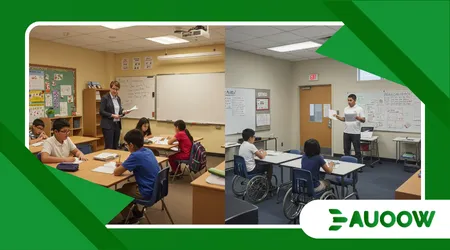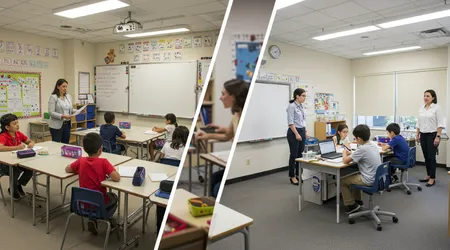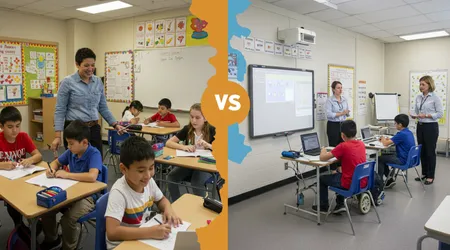Inclusive Classrooms vs. Special Ed Rooms: What’s Really Better?

Inclusive classrooms vs. special ed rooms spark heated debates among educators, parents, and policymakers striving to create equitable learning environments.
The question isn’t just about where students with disabilities learn best but how we define “best” in a system balancing diverse needs.
This article dives into the nuances of both approaches, exploring their strengths, challenges, and real-world implications.
With the global push for inclusion, driven by policies like the U.S.’s Individuals with Disabilities Education Act (IDEA), understanding these models is crucial.
Let’s unpack the evidence, weigh practical examples, and ask: Are we truly meeting every student’s needs, or are we chasing ideals at the expense of reality?
Education in 2025 demands flexibility, empathy, and innovation. The rise of inclusive education reflects a societal shift toward valuing diversity, yet special education rooms remain vital for some.
This piece examines both systems through a lens of fairness, effectiveness, and student outcomes, using real data and grounded insights.
We’ll explore how inclusive classrooms vs. special ed rooms shape academic and social growth, offering clarity for educators and families navigating this complex choice.
Understanding Inclusive Classrooms
Inclusive classrooms integrate students with and without disabilities, fostering shared learning. The goal? Equity, where all students access the curriculum together.
Teachers adapt lessons, often using universal design principles, to meet diverse needs. For example, a math lesson might include manipulatives for tactile learners and digital tools for others.
This approach thrives on collaboration. General and special education teachers co-plan, ensuring lessons suit all.
A 2023 study by Abt Associates found inclusive settings improve reading and math skills for students with disabilities. Socially, inclusion builds empathy.
Picture a classroom where a student with autism joins peers in a group project, learning teamwork.
Yet, inclusion isn’t flawless. Teachers need robust training to differentiate effectively. Without it, students with complex needs may struggle.
Imagine a teacher juggling 25 students, each with unique challenges can they truly meet everyone’s needs without support?
++ How Assistive Tech Is Leveling the Playing Field in Education
Inclusive classrooms demand resources. Schools must provide aides, technology, and time for co-planning.
When underfunded, inclusion risks becoming integration physical presence without true accommodation. A student with dyslexia might sit in class but lack tailored reading support.
The promise of inclusion lies in its community-building potential. Students learn to value differences, like a garden where varied plants thrive together.
But success hinges on preparation, not just good intentions. Schools must invest in training and tools to make inclusion work.

The Role of Special Education Rooms
Special education rooms offer targeted support for students with significant disabilities.
These settings provide individualized instruction, like one-on-one reading sessions for a student with severe dyslexia.
Inclusive classrooms vs. special ed rooms differ starkly here special ed rooms prioritize tailored intervention over group dynamics.
Smaller class sizes allow deeper focus. A student with ADHD might benefit from a quiet space to master focus strategies.
Also read: The Role of Teacher Training in Successful Inclusive Education
Data from the U.S. National Center for Education Statistics (2023) shows 60% of students with disabilities spend most of their day in general classrooms, yet 40% rely on special ed rooms for critical support.
Critics argue these rooms isolate students. A child in a special ed room might miss peer interactions, feeling “othered.” Yet, for some, the calm, structured environment is a lifeline.
Consider a student with sensory processing issues mainstream noise could overwhelm them.
Special ed rooms excel in intensive skill-building. A student with cerebral palsy might practice fine motor skills with a therapist, progress not easily replicated in a bustling classroom.
These rooms aren’t about segregation but precision, targeting specific needs.
The challenge? Stigma. Students may feel labeled, and parents often worry about social exclusion.
Schools must balance specialized support with opportunities for peer connection, ensuring special ed rooms complement, not replace, broader inclusion efforts.
Read more: How to Create IEPs That Actually Empower Students
Comparing Academic Outcomes
Academic success drives much of the inclusive classrooms vs. special ed rooms debate. Inclusive settings often boost achievement for students with mild disabilities.
The Abt Associates study (2023) showed inclusive students gained stronger literacy skills than those in segregated settings.
However, students with severe disabilities may thrive in special ed rooms. Focused instruction can close skill gaps faster. For example, a non-verbal student might master communication devices in a special ed room, progressing at their pace.
General classrooms risk overwhelming some students. A child with intellectual disabilities might struggle with fast-paced lessons without adequate support.
Special ed rooms offer tailored pacing, ensuring mastery before advancing.
Yet, inclusion fosters exposure to grade-level content.
A student with Down syndrome in an inclusive classroom might engage with the same science curriculum as peers, adapted to their level. This exposure builds confidence and ambition.
The data isn’t one-size-fits-all. Schools must assess individual needs. A hybrid model blending inclusive and special ed time often works best, offering both rigor and support. The key?
Flexibility to adapt to each student’s strengths.
Social and Emotional Impacts
Social growth shapes the inclusive classrooms vs. special ed rooms discussion. Inclusive classrooms promote belonging.
Students with disabilities form friendships, learning empathy alongside peers. A student with autism might share a lunch table, building social skills organically.
Special ed rooms, however, can limit peer exposure.
A 2021 survey by the National Education Association noted that students in segregated settings reported higher anxiety about social acceptance. Isolation can erode confidence, especially for teens.
Still, special ed rooms provide emotional safety for some. A student with severe anxiety might find mainstream settings overwhelming but flourish in a quieter, structured space. It’s like a cozy nook in a noisy world.
Inclusion’s social benefits depend on culture. Classmates must embrace diversity, or inclusion risks bullying. Teachers play a pivotal role, modeling respect. A classroom charter emphasizing kindness can set the tone.
Balancing social and emotional needs requires nuance.
Schools might pair inclusive classes with targeted social skills groups, ensuring students with disabilities feel both included and supported. The goal is belonging without sacrifice.

Teacher Preparedness and Resources
Teachers are the backbone of both inclusive classrooms vs. special ed rooms. Inclusive teaching demands versatility adapting lessons for diverse learners.
Yet, many lack training. A 2024 EdWeek report noted 70% of teachers feel underprepared for inclusion.
Special education teachers, trained in individualized strategies, shine in special ed rooms.
They might use visual schedules to help a student with autism stay on task. Their expertise is invaluable but stretched thin in inclusive settings.
Co-teaching is a game-changer for inclusion. A general and special education teacher might team up, one leading the lesson while the other supports small groups. This requires time and trust, often in short supply.
Resources matter. Inclusive classrooms need aides, adaptive tech, and flexible curricula.
Special ed rooms require specialized tools, like sensory equipment. Budget cuts often hit these essentials first, undermining both models.
Professional development is critical. Schools investing in ongoing training see better outcomes. Teachers need strategies, not just ideals, to make inclusive classrooms vs. special ed rooms work effectively for all students.
Table: Key Differences Between Inclusive Classrooms and Special Ed Rooms
| Aspect | Inclusive Classrooms | Special Ed Rooms |
|---|---|---|
| Setting | General classroom with diverse students | Separate room with smaller groups |
| Instruction | Adapted for all, often co-taught | Individualized, targeting specific needs |
| Social Interaction | High peer engagement, fosters belonging | Limited peer interaction, may feel isolating |
| Resource Needs | Aides, tech, teacher training | Specialized tools, therapists, small class sizes |
| Best For | Students with mild-moderate disabilities | Students with severe or complex needs |
Systemic Challenges and Solutions
The inclusive classrooms vs. special ed rooms debate exposes systemic gaps. Underfunding plagues schools, limiting aides and training.
The U.S. Department of Education reported a $12 billion special education funding shortfall in 2024.
Policy shapes outcomes. IDEA mandates the least restrictive environment, pushing inclusion.
Yet, vague guidelines leave schools scrambling. Clearer standards could ensure consistent support across districts.
Community buy-in is vital. Parents of non-disabled students sometimes resist inclusion, fearing reduced attention for their kids. Schools must communicate benefits, like how inclusion fosters empathy for all.
Hybrid models offer solutions. A student might spend mornings in an inclusive classroom and afternoons in a special ed room for targeted support. This balances social and academic needs effectively.
Technology can bridge gaps. Apps like speech-to-text tools empower students in inclusive settings.
Schools must invest in such innovations to make inclusive classrooms vs. special ed rooms a false dichotomy.
The Future of Education: A Balanced Approach

Looking ahead, the inclusive classrooms vs. special ed rooms debate may evolve into a hybrid future. Schools are experimenting with flexible models, blending inclusion with specialized support.
This approach honors individual needs while fostering community.
Emerging technologies, like AI-driven adaptive learning, could personalize education further. A student with dyslexia might use AI tools in an inclusive classroom, reducing reliance on separate rooms. Innovation is key.
Parent and student voices must guide policy. Surveys show families value choice some prefer inclusion, others specialized settings. Schools should offer both, tailored to each child’s needs.
Teacher training must evolve. Universities are updating programs to emphasize inclusive strategies, preparing educators for diverse classrooms. This shift promises better outcomes for all students.
Ultimately, the goal isn’t choosing between inclusive classrooms vs. special ed rooms but creating systems where every student thrives.
Education, like a well-tuned orchestra, should harmonize diverse voices into a cohesive whole.
Conclusion
The inclusive classrooms vs. special ed rooms debate isn’t about declaring a winner but finding balance.
Inclusive classrooms foster equity and social growth, while special ed rooms offer precision and focus.
Data, like the 2023 Abt Associates study, shows inclusion boosts literacy, but special ed rooms remain critical for intensive needs.
Schools must blend both, using hybrid models, technology, and robust training to meet diverse needs.
Every student deserves an education that sees their potential, not their limitations. By investing in resources and empathy, we can build classrooms where all belong.
FAQ: Inclusive Classrooms vs. Special Ed Rooms
What’s the main difference between inclusive classrooms and special ed rooms?
Inclusive classrooms integrate all students, adapting lessons for diversity. Special ed rooms provide targeted, individualized support for students with significant disabilities.
Do inclusive classrooms benefit all students?
Yes, inclusion promotes empathy and academic growth, but only with proper support. Without resources, students with disabilities may struggle, as may peers.
Are special ed rooms still necessary?
Absolutely. They offer specialized instruction for complex needs, like intensive therapy, that inclusive settings may not fully address without significant resources.
How can schools improve inclusion?
Invest in teacher training, aides, and adaptive tech. Foster a culture of respect and use hybrid models to balance inclusion with specialized support.
This exploration of inclusive classrooms vs. special ed rooms highlights the need for tailored solutions.
By blending both approaches, schools can ensure every student’s potential is nurtured, creating a truly equitable education system.
